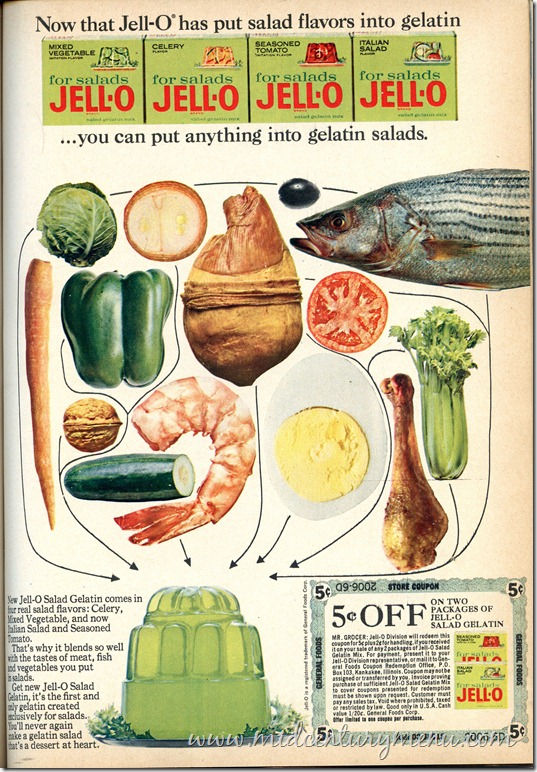There is Always Room for Jell-O
- Mary Stuart
- Aug 4, 2017
- 3 min read

My recent research into Jell-O and the many salad and dessert recipes that were published in mid-century America revealed numerous flavors, recipes, and even some disturbing trends sponsored by the Jell-O company over the past 125 years. I have warm vintage memories of the fake fruity and sugary goodness of the little packet of powder mixed first with hot liquid and then with cold. I remember being fed plain red Jell-o when my stomach wanted to turn inside out and eating Jell-O salads at church potlucks and big family dinners. The Jell-O salads I remember contained no vegetables but they often held canned fruit along with a diced apple and banana. If children were especially fortunate the Jell-O salad contained chemical whip (Cool Whip or other fake whipped cream). If the Jell-O salad was made by a real prankster mother it contained cottage cheese instead. These unfortunate dishes were often made with orange or green Jell-O but my family never ventured down this path.
Jell-O has played a significant role in American culinary history beginning with a powdered form of gelatin that was first patented by Peter Cooper in 1845. Cooper attempted to market his new product but it did not gain popularity in American kitchens 1897 when Pearle Bixby Wait and his wife Mary had the idea of adding strawberry, raspberry, orange, and lemon flavoring and sugar to powdered gelatin; they trademarked their gelatin dessert as Jell-O. When Jell-O did not bring about desired sales they sold out to Francis Woodward owner of the Genesee Pure Food Company in 1899.

Woodward was full of ideas on how he might market this new purchase but sales continued to languish. Beginning in 1902 Woodward placed numerous advertisements in the Ladies Home Journal Magazine but Jell-O was still only a minor success until he flooded the marketplace with free Jell-O cookbooks. He struck pay dirt!! Women across America now knew what to do with the little box of fruit flavored powder and sales soared. Jell-O gained such tremendous popularity that by 1923 it claimed to be America's Most Famous Dessert.

In the 1930s the new food trend was for congealed salads and aspics. Jell-O recognized the trend and promptly introduced lime flavored gelatin to complement popular congealed salad add-ins such as cabbage, celery, green peppers, onions, carrots and olives. By the 1950s congealed salads became so popular that Jell-O responded with vegetable flavors including celery, seasoned tomato, mixed vegetable, and Italian salad. These flavors enjoyed brief popularity but were discontinued by 1966 due to low sales.
One of the most popular congealed salads, loved for decades, was called Perfection Salad. Mrs. John E. Cook entered this savory Jell-O salad in a 1904 cooking competition judged by Fannie Merritt Farmer and other great foodies of the day. Her salad took third place and earned Mrs. Cook a sewing machine. Her salad was a homemaking magazine favorite for decades thereafter. A 1963 Better Homes and Garden article featuring Perfection Salad stated, "The beauty of the dish is that most any of the usual salad suspects may be added—cabbage, celery, carrots, olives, whatever week-old produce you find in your fridge—and it still looked attractive." Perfection Salad was often served alongside grilled meats or fish; Mrs. Cook liked it with fried oysters. The original recipe calls for the molded salad to be diced and served with mayonnaise, “in cases made of red or green peppers.” Vintage American cooks preferred to set their salads in molds. Tupperware molds were especially popular but Pyrex glass and metal molds were also widely used.

Fueled by the needs of the Baby Boom generation for quick meals and convenience food products the sales of Jell-O continued to soar through the 1950s and into the 1970s. The Jell-O ad campaigns applied brilliant marketing strategies to entice American women entering the workforce to rely upon Jell-O for quick, healthy, and nourishing salads and desserts. All she needed was boiling water and Jell-O.
Jell-O sales lagged in the latter part of the 1970s and into the 1980s but Jell-O continues to brilliantly market the fake fruity and sugary goodness of the little packet of powder so that sales are still strong nearly 125 years after Pearle Bixby Wait and his wife Mary had the idea of adding strawberry, raspberry, orange, and lemon flavoring and sugar to powdered gelatin.
Yes, indeed. Just as a 1964 television ad stated, "there is always room for Jell-O."





Comments